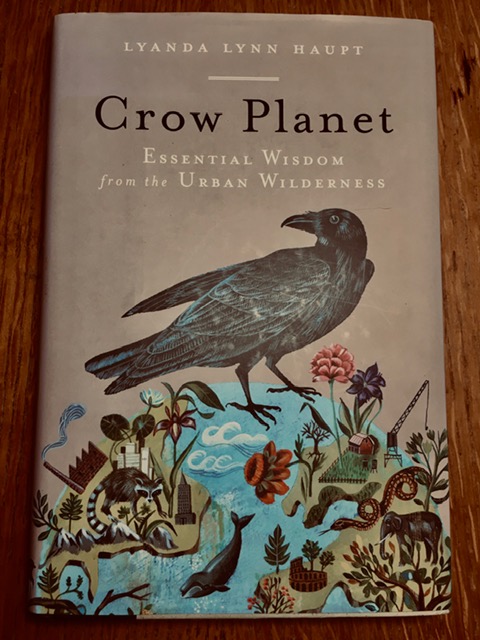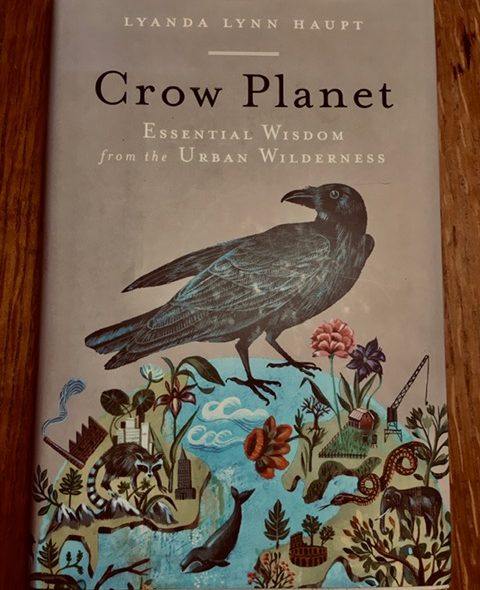My friend gave me an attractively covered book to add to the Little Free Library I have in front of my house. But when I examined Crow Planet “Essential Wisdom from the Urban Wilderness” by Lynda Lynn Haupt I realized I wasn’t ready to give this book up.
Crow Planet begins with the author, suffering from depression, looking out the bedroom window of the new suburban home her husband and she just purchased in Seattle, Washington. It’s midday but she’s still in her pajamas, seeing no reason to get dressed. Suddenly twelve feet away she sees a nest and hears a tiny bird preening. Looking through her binoculars, she sees a baby crow with a malignant growth over one eye. Both she and the baby bird are injured she thinks, crying and laughing at the same time.
Haupt is a scientist of the natural world who once worked as wildlife rehabilitator and in addition raised nearly a hundred fledging birds. She is also mother of a young daughter also fascinated with birds. After seeing the suffering baby crow, she captures, feeds and when it is healed frees it to join the hundreds of crows she sees daily on her nature walks. She begins to understand that Seattle can become the beloved wilderness she reluctantly left behind when she and her family moved to the city. She learns that urban nature is infused with magic and wonder and I, the reader, do too. The baby crow creates a “liaison with a truer way of being” that is not the romanticized Walden of Thoreau’s “pure nature”, but her — and our—natural world.
Crows are birds of the Corvid family which is several million years older than humans. Most crow populations are increasing while globally birds are declining due to human environmental destruction. This likely is because crows are omnivores who eat anything, scavengers who feed upon the dead (hence the term “murder of crows”).
Crows are also immensely intelligent in a way similar to apes which is why their behavior is so complex. They have an extensive vocabulary, for example a “remonstrative call” consisting of scolding and screeching if you get too close to a nest. They use mimicry. They also whisper, whine, meow, croak, chuckle and whinny. Crows take care of one another; they can use tools and are able to “reach a contemplative state while sunning themselves”. Crows may have a “helper” third crow to tend their young along with the mother, father and babies in a nest. Crows also attend “funerals”, gathering around their own dead. This is known as “mobbing”.
“Everybody has a crow story,” Lyanda Lynee Haupt writes.
My story centers around my mother’s death. It began when I flew to Pittsburgh to be with her at what turned out to be the end of her two-year struggle with cancer. The doctors had predicted she had a few more months to live so I flew back to California to put my affairs in order, intending to return as soon as possible. Five days after I left her, mom died. I returned for the funeral.
Both times I was in Pittsburgh I stayed in mom’s condominium on the fifth floor of a brand new housing complex in Forest Hills. It was surrounded by old venerable trees and inhabited by hundreds, perhaps thousands of crows cawing morning and night. I wanted to believe the crows calling out incessantly in those dark trees were messages from my mom. I wanted to learn their language and talk through them to her. I still do.
I ‘ve placed Crow Planet in the Little Free Library at the bottom of my driveway now. Whenever I see the crows I feel myself once again staring through that window of my mother’s condo divining answers while outside the wild, free birds peck at the garbage and clean the street, then fly off, screeching and circling above me—“Portents” Lynda Lynn Haupt writes, “of nothing but themselves, swirling like all of us in our beautiful, tangled, transitory lives.”


